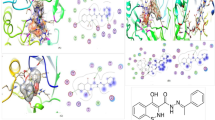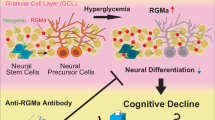Abstract
Aim:
To examine the effects of pioglitazone, a PPARγ agonist, on memory performance and brain amyloidogenesis in streptozotocin (STZ)-induced diabetic mice.
Methods:
ICR male mice were injected with STZ (150 mg/kg, iv) to induce experimental diabetes. Pioglitazone (9 and 18 mg·kg-1·d-1, po) was administered for 6 weeks. Passive avoidance and Morris water maze (MWM) tests were used to evaluate cognitive function. The blood glucose and serum insulin levels were detected using the glucose oxidase method and an ELISA assay, respectively. β-amyloid (Aβ), β-amyloid precursor protein (APP), β-amyloid precursor protein cleaving enzyme 1 (BACE1), NF-κB p65, the receptor for advanced glycation end products (RAGE) and PPARγ in the brains were analyzed using Western blotting assays.
Results:
The STZ-induced diabetic mice characterized by hyperglycemia and hypoinsulinemia performed poorly in both the passive avoidance and MWM tests, accompanied by increased Aβ1–40/Aβ1–42, APP, BACE1, NF-κB p65 and RAGE levels and decreased PPARγ level in the hippocampus and cortex. Chronic pioglitazone treatment significantly ameliorated the memory deficits and amyloidogenesis of STZ-induced diabetic mice, and suppressed expression of APP, BACE1, RAGE and NF-κB p65, and activated PPARγ in the hippocampus and cortex. However, pioglitazone did not significantly affect blood glucose and insulin levels.
Conclusion:
Pioglitazone ameliorates memory deficits in STZ-induced diabetic mice by reducing brain Aβ level via activation of PPARγ, which is independent of its effects on blood glucose and insulin levels. The results suggest that pioglitazone may be used for treating the cognitive dysfunction in type 1 diabetes mellitus.
Similar content being viewed by others
Log in or create a free account to read this content
Gain free access to this article, as well as selected content from this journal and more on nature.com
or
References
Biessels GJ, Deary IJ, Ryan CM . Cognition and diabetes: a lifespan perspective. Lancet Neurol 2008; 7: 84–90.
Kodl CT, Seaquist ER . Cognitive dysfunction and diabetes mellitus. Endocr Rev 2008; 29: 494–511.
Wrighten SA, Piroli GG, Grillo CA, Reagan LP . A look inside the diabetic brain: contributors to diabetes-induced brain aging. Biochim Biophys Acta 2009; 1792: 444–53.
Biessels GJ, Kamal A, Urban IJ, Spruijt BM, Erkelens DW, Gispen WH . Water maze learning and hippocampal synaptic plasticity in streptozotocin-diabetic rats: effects of insulin treatment. Brain Res 1998; 800: 125–35.
Biessels GJ, Cristino NA, Rutten GJ, Hamers FP, Erkelens DW, Gispen WH . Neurophysiological changes in the central and peripheral nervous system of streptozotocin-diabetic rats: course of development and effects of insulin treatment. Brain 1999; 122: 757–68.
Sima AA, Li ZG . The effect of C-peptide on cognitive dysfunction and hippocampal apoptosis in type 1 diabetic rats. Diabetes 2005; 54: 1497–505.
Sima AA, Zhang W, Muzik O, Kreipke CW, Rafols JA, Hoffman WH . Sequential abnormalities in type 1 diabetic encephalopathy and the effects of C-Peptide. Rev Diabet Stud 2009; 6: 211–22.
Sims-Robinson C, Kim B, Rosko A, Feldman EL . How does diabetes accelerate Alzheimer disease pathology? Nat Rev Neurol 2010; 6: 551–9.
Peila R, Rodriguez BL, Launer LJ, Honolulu-Asia Aging Study. Type 2 diabetes, APOE gene, and the risk for dementia and related pathologies: The Honolulu-Asia Aging Study. Diabetes 2002; 51: 1256–62.
Valente T, Gella A, Fernàndez-Busquets X, Unzeta M, Durany N . Immunohistochemical analysis of human brain suggests pathological synergism of Alzheimer's disease and diabetes mellitus. Neurobiol Dis 2010; 37: 67–76.
Li ZG, Zhang W, Sima AA . Alzheimer-like changes in rat models of spontaneous diabetes. Diabetes 2007; 56: 1817–24.
Hong H, Liu LP, Liao JM, Wang TS, Ye FY, Wu J, et al. Downregulation of LRP1 at the blood-brain barrier in streptozotocin-induced diabetic mice. Neuropharmacology 2009; 56: 1054–9.
Jolivalt CG, Hurford R, Lee CA, Dumaop W, Rockenstein E, Masliah E . Type 1 diabetes exaggerates features of Alzheimer's disease in APP transgenic mice. Exp Neurol 2010; 223: 422–31.
Liu Y, Liu H, Yang J, Liu X, Lu S, Wen T, et al. Increased amyloid beta-peptide (1–40) level in brain of streptozotocin-induced diabetic rats. Neurosci 2008; 153: 796–802.
Qu ZS, Tian Q, Zhou XW, Wang XC, Wang Q, Zhang Q, et al. Alteration of beta-amyloid and glutamate transporter in the brain of diabetes rats and the underlying mechanism. Zhongguo Yi Xue Ke Xue Yuan Xue Bao 2005; 27: 708–11.
Shuli S, Yongmei Z, Zhiwei Z, Zhijuan J . beta-Amyloid and its binding protein in the hippocampus of diabetic mice: effect of APP17 peptide. Neuroreport 2001; 12: 3317–9.
Takeda S, Sato N, Uchio-Yamada K, Sawada K, Kunieda T, Takeuchi D, et al. Diabetes-accelerated memory dysfunction via cerebrovascular inflammation and Abeta deposition in an Alzheimer mouse model with diabetes. Proc Natl Acad Sci U S A 2010; 107: 7036–41.
Sood V, Colleran K, Burge MR . Thiazolidinediones: a comparative review of approved uses. Diabetes Technol Ther 2000; 2: 429–40.
Nicolakakis N, Hamel E . The nuclear receptor PPARgamma as a therapeutic target for cerebrovascular and brain dysfunction in Alzheimer's disease. Front Aging Neurosci 2010; 2: 21–6.
Jiang LY, Tang SS, Wang XY, Liu LP, Long Y, Hu M, et al. PPARγ agonist pioglitazone reverses memory impairment and biochemical changes in a mouse model of type 2 diabetes mellitus. CNS Neurosci Ther 2012; 18: 659–66.
Morris R . Developments of a water-maze procedure for studying spatial learning in the rat. J Neurosci Methods 1984; 11: 47–60.
Karran E, Mercken M, De Strooper B . The amyloid cascade hypothesis for Alzheimer's disease: an appraisal for the development of therapeutics. Nat Rev Drug Discov 2011; 10: 698–712.
Rincon N, Xu K, Li J, Martinez JA, Hernandez MA, Singh GS, et al. Blockade of receptor for advanced glycation end products in a model of type 1 diabetic leukoencephalopathy. Diabetes 2012. DOI: 10.2337/db12-0317.
Chami L, Buggia-Prévot V, Duplan E, Delprete D, Chami M, Peyron JF, et al. Nuclear factor-κB regulates βAPP and β- and γ-secretases differently at physiological and supraphysiological Aβ concentrations. J Biol Chem 2012; 287: 24573–84.
Brands AM, Kessels RP, Hoogma RP, Henselmans JM, van der Beek Boter JW, Kappelle LJ, et al. Cognitive performance, psychological well-being, and brain magnetic resonance imaging in older patients with type 1 diabetes. Diabetes 2006; 55: 1800–6.
Hannonen R, Komulainen J, Eklund K, Tolvanen A, Riikonen R, Ahonen T . Verbal and academic skills in children with early-onset type 1 diabetes. Dev Med Child Neurol 2010; 52: e143–7.
Munshi M, Grande L, Hayes M, Ayres D, Suhl E, Capelson R, et al. Cognitive dysfunction is associated with poor diabetes control in older adults. Diabetes Care 2006; 29: 1794–9.
Glabe CG . Common mechanisms of amyloid oligomer pathogenesis in degenerative disease. Neurobiol Aging 2006; 27: 570–5.
Ballard C, Gauthier S, Corbett A, Brayne C, Aarsland D, Jones E . Alzheimer's disease. Lancet 2011; 377: 1019–31.
Han W, Li C . Linking type 2 diabetes and Alzheimer's disease. Proc Natl Acad Sci U S A 2010; 107: 6557–8.
Jung SW, Han OK, Kim SJ . Increased expression of β amyloid precursor gene in the hippocampus of streptozotocin-induced diabetic mice with memory deficit and anxiety induction. Neural Transm 2010; 117: 1411–8.
Guglielmotto M, Aragno M, Tamagno E, Vercellinatto I, Visentin S, Medana C, et al. AGEs/RAGE complex upregulates BACE1 via NF-kappaB pathway activation. Neurobiol Aging 2012; 33: 196.e13–27.
Bourne KZ, Ferrari DC, Lange-Dohna C, Rossner S, Wood TG, Perez-Polo JR . Differential regulation of BACE1 promoter activity by nuclear factor-B in neurons and glia upon exposure to beta-amyloid peptides. J Neurosci Res 2007; 85: 1194–204.
Bucala R, Cerami A . Advanced glycosylation: chemistry, biology, and implications for diabetes and aging. Adv Pharmacol 1992; 23: 1–34.
Thorpe SR, Baynes JW . Maillard reaction products in tissue proteins: New products and new perspectives. Amino Acids 2003; 25: 275–81.
Yamagishi S, Matsui T, Nakamura K . Kinetics, role and therapeutic implications of endogenous soluble form of receptor for advanced glycation end products (sRAGE) in diabetes. Curr Drug Targets 2007; 8: 1138–43.
Liu LP, Hong H, Liao JM, Wang TS, Wu J, Chen SS, et al. Upregulation of RAGE at the blood-brain barrier in streptozotocin-induced diabetic mice. Synapse 2009; 63: 636–42.
Mandrekar-Colucci S, Landreth GE . Nuclear receptors as therapeutic targets for Alzheimer's disease. Expert Opin Ther Target 2011; 15: 1085–97.
Pascual G, Fong AL, Ogawa S, Gamliel A, Li AC, Perissi V, et al. A SUMOylation-dependent pathway mediates transrepression of inflammatory response genes by PPAR-gamma. Nature 2005; 437: 759–63.
Acknowledgements
This work was supported, in part, by the Natural Science Foundation of Anhui Province, China (No 1208085MH164).
Author information
Authors and Affiliations
Corresponding author
Rights and permissions
About this article
Cite this article
Liu, Lp., Yan, Th., Jiang, Ly. et al. Pioglitazone ameliorates memory deficits in streptozotocin-induced diabetic mice by reducing brain β-amyloid through PPARγ activation. Acta Pharmacol Sin 34, 455–463 (2013). https://doi.org/10.1038/aps.2013.11
Received:
Accepted:
Published:
Issue date:
DOI: https://doi.org/10.1038/aps.2013.11
Keywords
This article is cited by
-
Prospective of managing impaired brain insulin signalling in late onset Alzheimers disease with excisting diabetic drugs
Journal of Diabetes & Metabolic Disorders (2019)
-
Sarsasapogenin suppresses Aβ overproduction induced by high glucose in HT-22 cells
Naunyn-Schmiedeberg's Archives of Pharmacology (2018)
-
RAGE-NF-κB-PPARγ Signaling is Involved in AGEs-Induced Upregulation of Amyloid-β Influx Transport in an In Vitro BBB Model
Neurotoxicity Research (2018)
-
Urtica dioica modulates hippocampal insulin signaling and recognition memory deficit in streptozotocin induced diabetic mice
Metabolic Brain Disease (2016)
-
Activation of α7nAChR Promotes Diabetic Wound Healing by Suppressing AGE-Induced TNF-α Production
Inflammation (2016)



